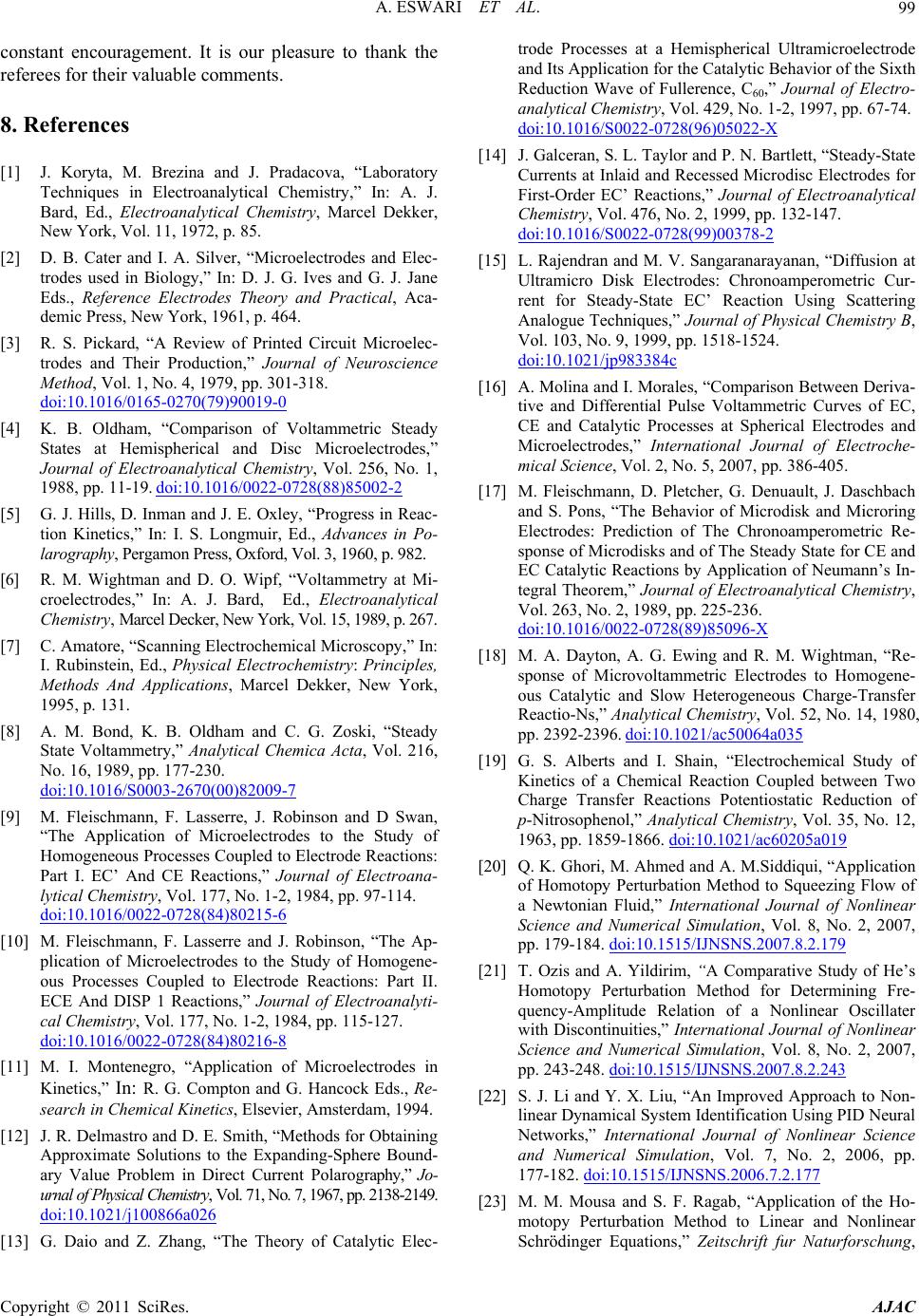
A. ESWARI ET AL.99
constant encouragement. It
hn
alytical Chemistry, Marcel Dekker,
New York, Vol. 11, 1972, p. 85.
I. A. Silver, “Microelectrodes and
trodes used in Biology,” In: D. J. G. Ives and G. J. Jane
is our pleasure to thank the
referees for their valuable comments.
8. References
[1] J. Koryta, M. Brezina and J. Pradacova, “Laboratory
Teciques in Electroanalytical Chemistry,” In: A. J.
Bard, Ed., Electroan
[2] D. B. Cater and Elec-
Eds., Reference Electrodes Theory and Practical, Aca-
demic Press, New York, 1961, p. 464.
[3] R. S. Pickard, “A Review of Printed Circuit Microelec-
trodes and Their Production,” Journal of Neuroscience
Method, Vol. 1, No. 4, 1979, pp. 301-318.
doi:10.1016/0165-0270(79)90019-0
[4] K. B. Oldham, “Comparison of Voltammetric Steady
States at Hemispherical and Disc Microelectrodes,”
Journal of Electroanalytical,
1988, pp. 11-19. oi:10.1016/0022-0728(88)85002-2
Chemistry, Vol. 256, No. 1
d
[5] G. J. Hills, D. Inman and J. E. Oxley, “Progress in Reac-
tion Kinetics,” In: I. S. Longmuir, Ed., Advances in Po-
larography, Pergamon Press, Oxford, Vol. 3, 1960, p. 982.
[6] R
croelectrod
. M. Wightman and D. O. Wipf, “Voltammetry at Mi-
es,” In: A. J. Bard, Ed., Electroanalytical
New York, Vol. 15, 1989, p. 26
ochemical Microscopy,” In:
Chemistry, Marcel Decker,
[7] C. Amatore, “Scanning Electr
7.
I. Rubinstein, Ed., Physical Electrochemistry: Principles,
Methods And Applications, Marcel Dekker, New York,
1995, p. 131.
[8] A. M. Bond, K. B. Oldham and C. G. Zoski, “Steady
State Voltammetry,” Analytical Chemica Acta, Vol. 216,
No. 16, 1989, pp. 177-230.
doi:10.1016/S0003-2670(00)82009-7
[9] M. Fleischmann, F. Lasserre, J. Robinson and D Swan,
“The Application of Microelectrod
Homogeneous Processes Coupled to
es to the Study of
Electrode Reactions:
nd CE Reactions,” Journal of Electroana-
try, Vol. 177, No. 1-2, 1984, pp. 97-114.
doi:10.1016/0022-0728(84)80215-6
Part I. EC’ A
lytical Chemis
urnal of Electroanalyti-
[10] M. Fleischmann, F. Lasserre and J. Robinson, “The Ap-
plication of Microelectrodes to the Study of Homogene-
ous Processes Coupled to Electrode Reactions: Part II.
ECE And DISP 1 Reactions,” Jo
cal Chemistry, Vol. 177, No. 1-2, 1984, pp. 115-127.
doi:10.1016/0022-0728(84)80216-8
[11] M. I. Montenegro, “Application of Microelectrodes in
Kinetics,” In: R. G. Compton and G. Hancock Eds., Re-
here Bound-
t Polarography,” Jo-
search in Chemical Kinetics, Elsevier, Amsterdam, 1994.
[12] J. R. Delmastro and D. E. Smith, “Methods for Obtaining
Approximate Solutions to the Expanding-Sp
ary Value Problem in Direct Curren
urnal of Physical Chemistry, Vol. 71, No. 7, 1967, pp. 2138-2149.
doi:10.1021/j100866a026
[13] G. Daio and Z. Zhang, “The Theory of Catalytic Elec-
trode Processes at a Hemispherical Ultramicroelectrode
nd It
edu
728(96)05022-X
as Application for the Catalytic Behavior of the Sixth
Rction Wave of Fullerence, C60,” Journal of Electro-
analytical Chemistry, Vol. 429, No. 1-2, 1997, pp. 67-74.
doi:10.1016/S0022-0
tate
[14] J. Galceran, S. L. Taylor and P. N. Bartlett, “Steady-S
Currents at Inlaid and Recessed Microdisc Electrodes for
First-Order EC’ Reactions,” Journal of Electroanalytical
Chemistry, Vol. 476, No. 2, 1999, pp. 132-147.
doi:10.1016/S0022-0728(99)00378-2
[15] L. Rajendran and M. V. Sangaranarayanan, “Diffusion at
Ultramicro Disk Electrodes: Chronoamperometric Cur-
rent for Steady-State EC’ Reaction Using Scattering
Analogue Techniques,” Journal of Physical Chemistry B,
Vol. 103, No. 9, 1999, pp. 1518-1524.
doi:10.1021/jp983384c
[16] A. Molina and I. Morales, “Comparison Between Deriva-
nal Journal of Electroche-
.
nalytical Chemistry,
tive and Differential Pulse Voltammetric Curves of EC,
CE and Catalytic Processes at Spherical Electrodes and
Microelectrodes,” Internatio
mical Science, Vol. 2, No. 5, 2007, pp. 386-405
[17] M. Fleischmann, D. Pletcher, G. Denuault, J. Daschbach
and S. Pons, “The Behavior of Microdisk and Microring
Electrodes: Prediction of The Chronoamperometric Re-
sponse of Microdisks and of The Steady State for CE and
EC Catalytic Reactions by Application of Neumann’s In-
tegral Theorem,” Journal of Electroa
Vol. 263, No. 2, 1989, pp. 225-236.
doi:10.1016/0022-0728(89)85096-X
[18] M. A. Dayton, A. G. Ewing and R. M. Wightman, “Re-
sponse of Microvoltammetric Electrodes to Homogene-
ous Catalytic and Slow Heterogeneous Charge-Transf
Reactio-Ns,” Analytical Chemistry, V
er
ol. 52, No. 14, 1980,
pp. 2392-2396. doi:10.1021/ac50064a035
[19] G. S. Alberts and I. Shain, “Electrochemical Study of
Kinetics of a Chemical Reaction Coupled between Two
Charge Transfer Reactions Potentiostatic Reduction of
p-Nitrosophenol,” Analytical Chemistry, Vol. 35, No. 12,
1963, pp. 1859-1866. doi:10.1021/ac60205a019
[20] Q. K. Ghori, M. Ahmed and A. M.Siddiqui, “Application
of Homotopy Perturbation Method to Squeezing Flow of
a Newtonian Fluid,” International Journal of Nonlinear
Science and Numerical Simulation, Vol. 8, No. 2, 2007,
pp. 179-184. doi:10.1515/IJNSNS.2007.8.2.179
[21] T. Ozis and A. Yildirim, “A Comparative Study of He’s
Homotopy Perturbation Method for Determining Fre-
quency-Amplitude Relation of a Nonlinear Oscillater
with Discontinuities,” International Journal of Nonlinear
Science and Numerical Simulation, Vol. 8, No. 2, 2007,
pp. 243-248. doi:10.1515/IJNSNS.2007.8.2.243
[22] S. J. Li and Y. X. Liu, “An Improved Approach to Non-
linear Dynamical System Identification Using PID Neural
Networks,” International Journal of Nonlinear Science
and Numerical Simulation, Vol. 7, No. 2, 2006, pp.
177-182. doi:10.1515/IJNSNS.2006.7.2.177
[23] M. M. Mousa and S. F. Ragab, “Application of the Ho-
motopy Perturbation Method to Linear and Nonlinear
Schrödinger Equations,” Zeitschrift fur Naturforschung,
Copyright © 2011 SciRes. AJAC